Ruhr Area - Tumblr Posts
- English -
The “Old Cruise” of the Dortmund-Ems Canal near Olfen

In Olfen the Ruhr area becomes the Münsterland region. Agriculture increases suddenly, there are floodplains and the density of settlements decreases. A tour on a bike or a walk is particularly worthwhile here: Olfen has also undergone an exciting development and experienced very special relics of a decommissioned infrastructure.

There is a closed bypass of one of the most important federal waterways in Germany, the Dortmund-Ems Canal. This is an approximately 226 km long artificial waterway between Dortmund and Papenburg on Ems.

The ceremonial opening took place on August 11, 1899, in the presence of Emperor Wilhelm II., after an extremely short construction period of just seven years. From the beginning, the main goals were to relieve the burden on the railways and simplify the transportation of coal from the Ruhr area.

The canal that runs to the North Sea should only be the first step for an entire waterway network. As a connection to the Elbe river, the Mittelland Canal, which of course was still called the Kaiser Wilhelm Canal at that time, was built a few years later.

The Dortmund-Ems Canal originally ran on the section between the Datteln Canal Cross with the nearby Henrichenburg boat lift and Münster city. Directly past the center of Olfen, where there was even a small port. However, the construction of a bypass around Olfen began as early as 1929.

The reason for this was the growing shipping traffic and, of course, new & larger dimensions of the ships. While the canal could simply be dredged wider elsewhere, it wasn´t so easy in Olfen, where the canal ran high above the surrounding country.

Since 1937 the canal has been running on a straightened and widened line southeast of the city. This is called New Cruise or Second Cruise, it´s the oldest of these kind on the Dortmund-Ems Canal. In the further course of the canal, there are a few more bypasses.

With the new cruise, the cruise that have now become the old cruise became less important. In the 1980s, partly because of the high cost of maintenance, it was decided to dismantle this section, with part of the canal and in particular the landscape bridges of Lippe river and Stever river remaining at the canal.

The canal character from the Datteln Sea towards Olfen is still preserved. In sections separated by transverse dams, a long biotope has emerged with a reduced water level, which ends at the former city port of Olfen. The canal is filled up in the city center.

Only at the northern end, where he meets the second cruise, has a marina been built on the old canal route. In the town center, it became an elongated green area on a high causeway with a tree trail. Today the cycle route "Dortmund-Ems Canal", the tour “around Olfen” and the “Stever floodplain trail” run on it.

The preserved Art Nouveau canal bridges from the Emperor period are architecturally impressive. The material is made of sandstone and cast-iron railings are installed in compatible style.
- English -
Herten Castle
The Herten moated castle is not far from the city center of Herten, what was once the largest mining town on the European continent.

This gem from the Middle Ages lies in the middle of the Ruhr area, in the middle of a large and remarkable castle park with ancient forest. The late Gothic castle and the extensive 30 hectare castle park invite you to visit with the whole family.

Herten Castle was first mentioned in 1376. The family of those von Herten, liege men of the Abbey Werden, was first mentioned in 1286 with Gerlach von Hertene. Their former residence is believed to be in the town center of Herten at the parish church of St. Antonius.

In the 14th century, the knightly family built a permanent house on the site of today's castle, which was mentioned in 1376 as a fief of the Imperial Abbey in Werden. Herten Castle was initially built as a small weir system. The remains of a keep can still be seen today. In the period that followed, expansion and conversion into a representative castle took place.

By marriage, the Herten house came to the Lords of Galen in the mid-14th century. The heiress Elseke brought it to her husband Dietrich von Stecke in 1488 through her marriage in 1476. Anna von Stecke married Bertram von Nesselrode in 1529, heir to the duchies of Jülich and Berg.

Like numerous members of the Nesselrode family, he was a politically influential nobleman at the time and from 1539 to 1556 he was governor of Cologne in the Vest Recklinghausen. From 1530 he had the castle expanded as a closed fort with corner pavilion towers. The towers are still standing today.

The estate remained in the possession of the von Nesselrode family for almost 300 years. After eventful years, a siege in 1593 and a fire almost a century later (1687), Herten Castle was rebuilt by Baron Franz von Nesselrode until 1702. Baron Franz von Nesselrode-Reichenstein was elevated to the status of imperial count by Emperor Leopold I in 1702.

When the last male representative of the von Nesselrode, Johann Franz Josef von Nesselrode, died in 1826, the castle came through Johann's daughter Charlotte to the von Droste zu Vischering family, who was also elevated to the status of an imperial count in the same year.

The members of their Herten lineage then called themselves Droste zu Vischering von Nesselrode-Reichenstein. The family lived at the Herten estate until shortly after the First World War. However, after they moved to Merten Castle in Eitorf from 1920 and thus gave up Herten Castle as a place of residence, it was left to decay.

The castle remained unused and fell visibly into disrepair until it was sold to the Landscapes Association of Westphalia-Lippe in 1974. The site was renovated until 1989, making it accessible to the public.

The State clinic for psychiatry and psychotherapy Herten is located in the western part, which also uses some historical buildings of the castle. The main castle is reached via a bridge from the outer castle, which in turn is surrounded by a moat and contains a coach house and chapel.

The main castle is today a late Gothic brick building with a closed courtyard. The four parts of the building surrounding it have the shape of a trapezoid. The castle with its characteristic corner towers is surrounded by a moat, a moat. The castle is partially accessible, for example, offers a restaurant, but is mainly used by the clinic.

After the Schlosspark was awakened from its more than 50-year-old sleeping beauty in 1974, as a People's park it is an integral part of the life of (not only) the people of Herten.

Between 1687 and 1702 the park was transformed from a strict baroque garden into a landscape park based on the English model. Count von Nesselrode even engaged Düsseldorf court gardener Maximilian Friedrich Weyhe to design the palace park.

The small pavilion, Tobacco house, in the castle park got its name from the two Counts Riaucourt - sons of a countess Nesselrode - who found shelter in Herten Castle from the French Revolution. In this garden shed they enjoyed the new fashion of smoking in front of the fireplace, which was frowned upon in the castle.

The orangery, built in 1725, was decorated by a balustrade with 12 statues at the time. It housed the garden casino, court parties were celebrated, orange and ornamental trees were raised and there was space for one of the most beautiful camellia collections.

In the meantime there is unfortunately only a ruin left. Missing repairs and mining damage hit the building, which was only partially renovated in the 1970s. The reconstruction of the surprisingly large orangery is still under discussion.

After the noble family moved from Nesselrode to Merten Castle in 1920, the park was only opened for special celebrations and processions. For nature and animals, it was a relaxing time behind the walls. The park overgrown, but also the Herten moated castle and the orangery decayed over time.

When the Land Association of Westphalia-Lippe bought the property with the castle in 1974, considerable renovation measures were necessary. Between 1974 and 1976 over 2 million DM were invested in the castle park alone. It was only made accessible when it was acquired by the state association.

Botanical treasures from all over the world can be found in the Herten castle park - chile fir trees, Japanese cypresses, katsura trees or catalpa and ghost trees. The star magnolia in front of the castle is one of the oldest in Westphalia.

The park was structured in a varied way with meadows, avenues, squares or even a rose garden and invites you to stroll. Rare giant trees, old forests, daffodil meadows, the maze and the open-air theater are grouped around the Herten Castle.

The castle ponds adjoin the picturesque moats, which are particularly impressive due to their biodiversity of waterfowl. Unfortunately, tons of invasive geese (Egyptian geese and Canada geese) have settled here, which obviously feel very comfortable and reproduce splendidly.

The green areas are correspondingly contaminated and the ponds are also badly affected by this overpopulation.

Entry to the castle park is possible 24/7 and free of charge!
Witten: Steinhausen Castle
- English -
The Steinhausen Castle is a medieval castle complex, built in the 13th century by the Lords of Witten as a court seat.

First documented in 1297, the castle was almost completely torn down in 1434 by knights from Dortmund, who had come across the river Ruhr with 700 foot servants, 50 riders and 12 wagons, and only rebuilt in a makeshift manner.
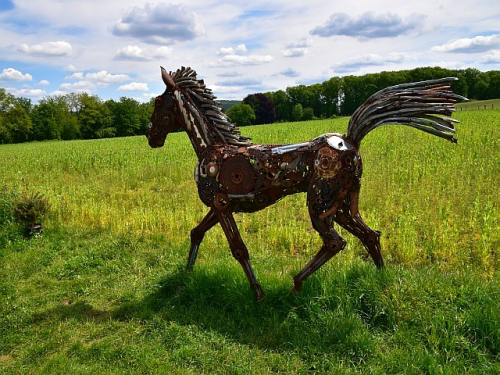
The Witten family died out without male heir. By marrying the heiress Jutta von Witten with knight Lutter Stael von Holstein zu Hardenstein, bailiff to Bochum and Wetter, the knight's seat "Steinhus" came to the Stael von Holstein family in 1464 and remained in their possession for almost three centuries.
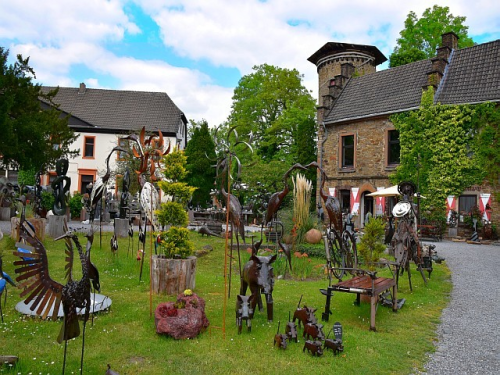
Lutter's grandson Hardenberg Stael von Holstein, lord of Steinhausen and Dahlhausen, rebuilt the castle in 1529. Robert Stael von Holstein had the tower with a pointed roof and the stepped gable house erected in 1607, as evidenced by the Stael von Holstein coat of arms above the arched door and the inscription: "robbert stael von holstein thumler zu hildesheim built me".
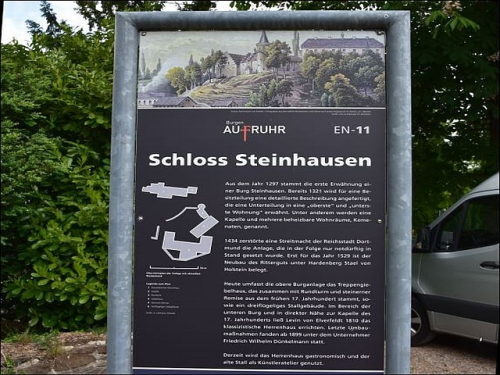
Robert Werner Stael von Holstein, lord of Steinhausen, Dahlhausen and Martfeld, had the chapel built at Steinhausen castle in 1648, where the grave slabs of the family members can still be seen today. The last male offspring of the Stael family from Holstein zu Steinhausen - Wolfgang Robert Leopold, lord of Steinhausen, Martfeld and Lövenich - died in 1729.

His daughters Helena Margareta and Maria Helena, both canonesses to Asbeck, transferred in 1732 (as transaction inter vivos) Castle Steinhausen and the mines in the Ruhr Valley, that had been operated by the Stael von Holstein family since the 17th century, to baron Friedrich Christian von Elverfeldt zu Dahlhausen, grandson of Robert von Elverfeldt and his wife Anna Kunigunde Stael von Holstein zu Steinhausen.

Levin von Elverfeldt built the classicist Steinhausen castle in 1810. The landmark of the old tower on the gable house, the pointed tower, no longer rises above the river Ruhr today. The top was removed due to mining damages and rotten beams.

In the following centuries Steinhausen castle changed hands several times and was converted into a romantic manor at the end of the 19th century. Little reminded that this is a former hilltop mediaeval castle.

The historicist chapel stands on the northeast corner of the manor house. Basically from 1648, it underwent a fundamental redesign in 1904 according to the then prevailing taste of Art Nouveau.
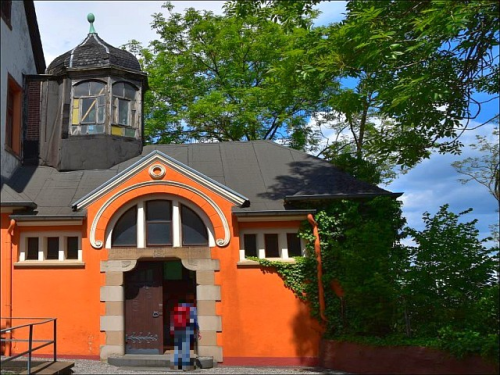
Inside you can see old grave slabs from the 15th to 18th centuries, including the Hardenberg Stael grave stone from Holsteins. The chapel at Steinhausen was built on rocky ground under Robert Stael von Holstein in 1648.

The crypt under the chapel, with archaic cube capitals, was used as a private burial site for the Dünkelberg family until about 1920. The chapel has been lovingly restored and is now accessible again.

The chapel of Steinhausen castle probably had two bells, cast around 1200 and 1500 AD. On one of the bells was the coat of arms of Hardenberg and Stael von Holstein and the inscription "St. Antonius beg for us".
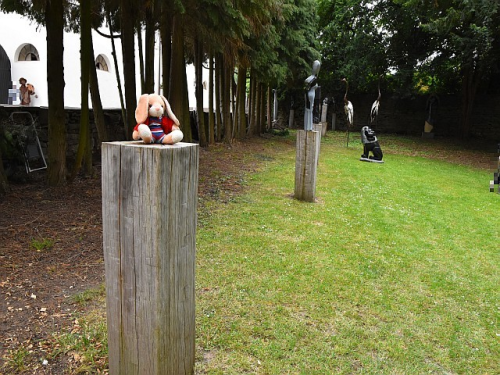
The bell can also come from the former Hardenstein Castle. The Antonius chapel of Hardenstein Castle is mentioned in a document in 1363. Heinrich von Hardenberg died in 1439, the last Hardenberger at Hardenstein Castle. By marriage, the castle came to Stael von Holstein in 1529.

The chapel is not consecrated, but a small altar, a noble cross, saints pictures and pews invite you to pray. Or at least to rethink and switch off. An even older, quieter place of rest lies under the chapel - the crypt, built in 1642.
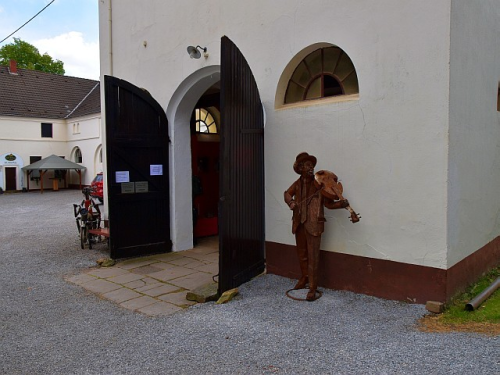
Until the 1950s or 1960s, the Oberste-Frielinghaus family also had their bodies buried here. The coffins were then transferred, the grave slabs still hang in the chapel. The crypt is now empty and will soon be renovated. But it will remain a devout place of silence.
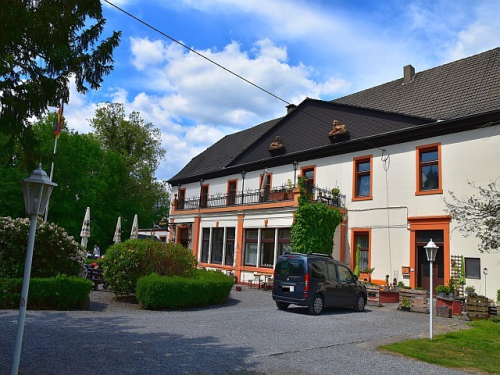
Today, Steinhausen Castle houses a beautiful restaurant with outdoor dining in Witten-Bommern above the river Ruhr. In the courtyard, a beer garden invites you to enjoy the sunshine between old walls. Weddings are also possible at Steinhausen Castle.
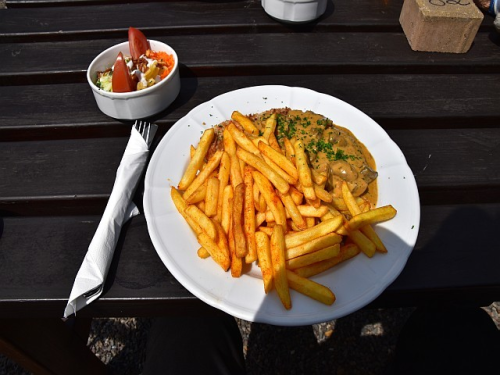
A stonemason can be found in the old stables today. The old gable house is used by the Local Heritage Society, which also strives to preserve the historic buildings and rebuild the old spire.
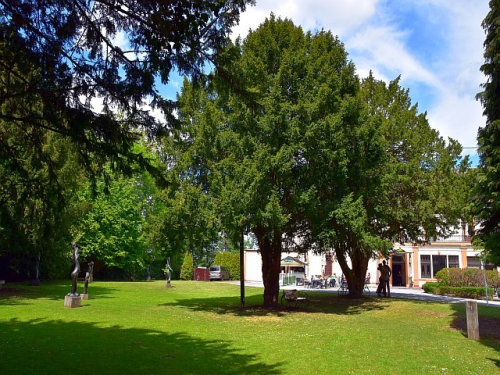
In the castle park, which invites you to look, marvel and linger, there is a worth seeing permanent exhibition of Shona sculptures from Zimbabwe. Most pieces can also be purchased. Highly recommended!

Zimbabwe's contemporary stone sculpture as the youngest art form in Africa has spawned an incredible number of talents in its sixty years of history. SHONA - ART is concerned with building an economic bridge between Europe and Africa.

All kinds of African animals can be found in and around the castle. You won't see giraffes, elephants and birds in this abundance anywhere in Germany. The stone sculptures from Africa are exhibited in the castle courtyard and in a gallery building (coach house).
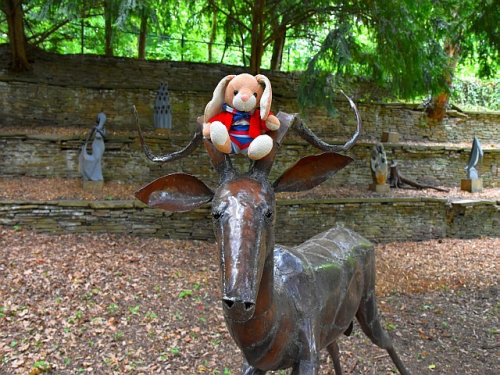
Zimbabwe is that country between Botswana, South Africa and Mozambique, which is worldwide known for its abundance of animals and the Victoria Falls. The outside area can be visited, but, apart from the gallery, the buildings not.
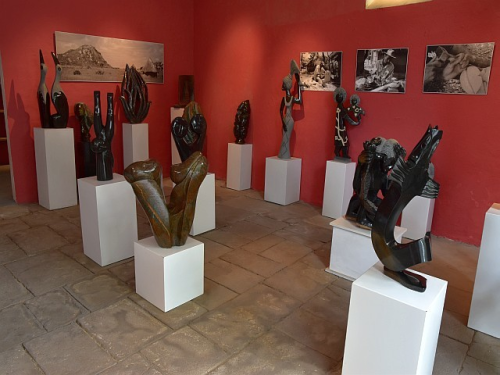
Nevertheless, Steinhausen Castle with its restaurant and permanent exhibition is a popular destination in the Ruhr valley. Free parking is available on the street "Auf Steinhausen", uphill to Steinhausen Castle.
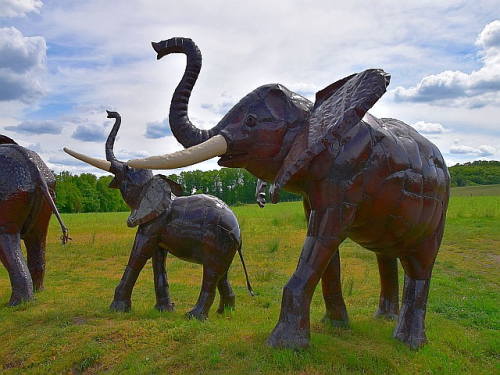
The narrow street ends directly at Steinhausen Castle. The gigantic metal animal sculptures are unmistakable: elephants, lions, giraffes, buffalos and other animals are watching all over the place.

Into the dark
Erleuchtung

Power plant


What's wrong with me ?



